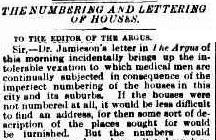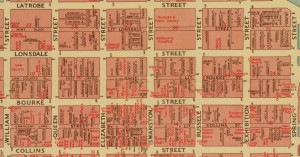In 1887, Melbourne City Council ordered the renumbering of properties across the city to make houses and businesses easier to find.
Elizabeth Street, Melbourne, IAN24/12/63/9
Up until this time, streets that ran east-west were divided at Elizabeth Street so that street numbers began at 1 on either side heading east to Spring Street and west to Spencer Street, for example, 61 Bourke Street East. Numbering of north-south streets began at Flinders Street and went north, as is still the case today. You can see this numbering system in The most complete popular & mercantile map of Melbourne from 1853.
The lack of consistent street numbering caused problems for deliveries of goods and services across Melbourne. During an outbreak of typhoid in February 1887, a doctor wrote to The Argus complaining about the difficulty of finding patients’ houses. He compared the process for numbering houses in Melbourne to corn sown in a field ‘by the simple process of scattering, so that although there are plenty of numbers, none of them are in the right places.’ He concluded his letter with the timeless observation that if the council ‘can afford to spend £10,000 in ornamentation of the town hall, I think they can bestow a much smaller sum upon work, of the neglect of which I am now complaining.’
The Argus, 8th Februrary 1887
Eventually, the Melbourne City Council did respond. According to the council minutes, a Mr JA Kay wrote a report for the Council’s Public Works Committee on the uniform numbering of houses in August 1887. The Argus records the councillors’ vigorous exchanges on the matter and Mr Kay’s proposal was approved at a meeting on 12 September 1887.
However, not everyone was happy with Council’s implementation of the new system. William Ball, a chemist working in Bourke Street wrote that the decision to allow one week for the change over was ‘very unjust and absurd’. He stated that the change would cost him over £100 in obsolete stationery, his printer having just produced 10,000 pamphlets with the old address. While Mr Ball saw the merit in a consistent street numbering system he felt that the Council should have provided residents and businesses with at least 6 months notice. He signed off his letter ‘W Ball 61 Bourke or 252 Bourke Street.’
You can view online the new numbering system in Morgan’s map of the city of Melbourne (above) from 1945. If you would like to find out more about street re-numbering in the city you can follow the story on the digitised newspapers on the Trove.
Written by Chris Wade (former Newspaper Librarian)





Interesting! To think we could have had a similar numbering system to the wonderful NYC!
I wonder this compared to other states at the time? i had wondered why an address of 1877 was called 10 bourke street east. now i know.
The streets running north south were also renumbered at this time. Due to many subdivisions, the north south numbers had also become very complicated. There were numbers such as 35 and a half. After the north-south renumbering, most addresses had higher numbers, e.g. what was previously a hotel at 187 Swanston Street (almost opposite the then Melbourne Public Library) had its number changed to 303 (but still almost opposite the Public Library).
Hi Jan,
Wondered if you could tell me the name of the hotel at 187 Swanston St….
Hi Frances
According to the Sands and McDougall directory from 1944/45, the State Savings Bank of Victoria was as 185-189 Swanston Street.
Paul
In 1885, before the renumbering in 1887, number was 187 Swanson St was between Lonsdale St & Little Lonsdale St.
It was Stewart’s Hotel. As Jan said, that 187 became 303.
After 1887, 187 Swanston St, is close to Bourke St, between Bourke & Little Bourke St. (The Commonwealth Bank is currently listed at 191 Swanston, but it’s across a few properties, so may include 187).
Before 1887, the State Bank (if it had existed) location would’ve been at about 117 or 119 Swanston St.
(there’s a small right-of-way lane next to those numbers – there before 1887 & still there).
119 Swanston St was Cleals Hotel
I was taught as a youngster that the numbering system was started at the GPO and radiated out from there. I was also taught that you walked on the left side of the footpath , how things have changed. Great to hear how the numbering system was created.
I was taught as a kid that street numbering started at the GPO and radiated out from there, also I was taught to walk on the left hand side of the footpath – well things have changed. Great to hear how street numbering was organised.
Can you tell me what numbers 35 & 37 Queensberry street City North (1927) would be today I believe they were near Capel Street
Hi Lorraine,
I will pass your enquiry to the Ask A Librarian service and someone will be in contact- to hopefully with an answer to your question.
Thanks
Paul
TKU
Fascinating content.
Do you know if Number 124 Spencer St in 1868 had its number changed later – and if so, to which? It would have carried the namr James Walker, Butcher. Family memories think it was once where Radio parts stands today (5-600 range).
Alternatively, do you know where I might find an answer?
Jeff walker
Hi Jeff,
Thanks for your comment. A librarian will be in touch shortly and respond to your enquiry.
Paul
In the early 1860s my great grandfather had a tobacco manufacturing business at 147 Lt Lonsdale St West (north side) – between King & Spencer Sts. Could you tell me please the ‘new’ number for 147 Lt Lonsdale St West
Thanks for your question Ken. I’ve transferred your inquiry to our Ask-a-librarian service.
You’ll be hearing from us soon.
Paul
Looking for information on the Gordon Royal was located in Swanston Street, in the early 1900’s any information would be appreciated
Thank You
Leanne
Hi Leanne, Thanks for your interest. I will log your question with our Ask a Librarian service, and one of our librarians will get back to you. Paul.
The North/South streets also had the premises renumbered. Addresses were getting ridiculous with numbers like 11 1/2 ‘so and so’ street. This because properties were getting subdivided. The new system of numbering reduced the numbers to a standard frontage, so a previous number of 224 might get renumbered 222-226 for example. I think the standardisation of frontages happened on the East/West streets as well.
Love the history of Melbourne while we’re still allowed to have history. Any chance you could tell me what was at 45 Collins Street 1820-1830. One of my ancestors worked there not sure if she was an assisted immigrant. Thanks
Hi Shirley, thanks for your enquiry. I will log your question with our ‘Ask a Librarian’ service and one of our librarians will be in touch. Paul
hello, the trove link to follow the story just goes to the main trove home page – is there a specific link that has been lost? thanks!
Hi Eloise,
I have updated the ‘follow the story’ link to ‘street’ “re-numbering” and 1887.
Thanks for reading the blog,
Paul